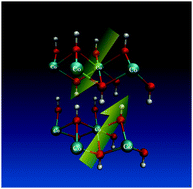The magnetic structure of β-cobalt hydroxide and the effect of spin-orientation†
Abstract
Synchrotron X-ray and neutron diffraction experiments at various temperatures, down to 3 K, along with ab initio calculations, are carried out to elucidate the magnetic order of layered β-cobalt-hydroxide. This combination of techniques allows for the unambiguous assignment of the magnetic structure of this material. Our results confirm that below the Néel temperature high-spin cobalt centers are ferromagnetically coupled within a layer, and antiferromagnetically coupled across layers (magnetic propagation vector k = (0,0,½)), in agreement with the indirect interpretation based on magnetic susceptibility measurements. A paramagnetic/antiferromagnetic transition is observed at around 15 K. Moreover, the thermal expansion behavior along the c-lattice direction, perpendicular to the layers, shows an inflection slightly above this temperature, at around 30 K. The neutron diffraction patterns and the non-collinear DFT+U calculations indicate that the magnetization forms an angle of about 35° with the cobalt planes. In particular, for an isolated ferromagnetic layer, the electronic structure calculations reveal sharp cusps on the potential energy surface when the spins point parallel or perpendicular to the planes, suggesting that the ferromagnetic superexchange mechanism is strongly sensitive to the orientation of the magnetic moment.


 Please wait while we load your content...
Please wait while we load your content...